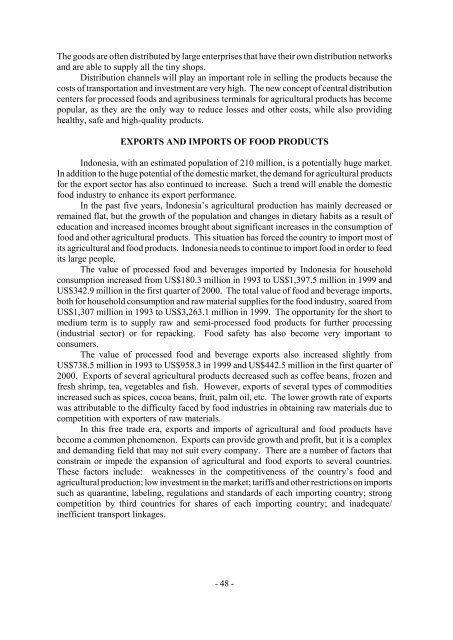Development of Agribusiness Enterprises - Asian Productivity ...
Development of Agribusiness Enterprises - Asian Productivity ...
Development of Agribusiness Enterprises - Asian Productivity ...
Create successful ePaper yourself
Turn your PDF publications into a flip-book with our unique Google optimized e-Paper software.
The goods are <strong>of</strong>ten distributed by large enterprises that have their own distribution networks<br />
and are able to supply all the tiny shops.<br />
Distribution channels will play an important role in selling the products because the<br />
costs <strong>of</strong> transportation and investment are very high. The new concept <strong>of</strong> central distribution<br />
centers for processed foods and agribusiness terminals for agricultural products has become<br />
popular, as they are the only way to reduce losses and other costs, while also providing<br />
healthy, safe and high-quality products.<br />
EXPORTS AND IMPORTS OF FOOD PRODUCTS<br />
Indonesia, with an estimated population <strong>of</strong> 210 million, is a potentially huge market.<br />
In addition to the huge potential <strong>of</strong> the domestic market, the demand for agricultural products<br />
for the export sector has also continued to increase. Such a trend will enable the domestic<br />
food industry to enhance its export performance.<br />
In the past five years, Indonesia’s agricultural production has mainly decreased or<br />
remained flat, but the growth <strong>of</strong> the population and changes in dietary habits as a result <strong>of</strong><br />
education and increased incomes brought about significant increases in the consumption <strong>of</strong><br />
food and other agricultural products. This situation has forced the country to import most <strong>of</strong><br />
its agricultural and food products. Indonesia needs to continue to import food in order to feed<br />
its large people.<br />
The value <strong>of</strong> processed food and beverages imported by Indonesia for household<br />
consumption increased from US$180.3 million in 1993 to US$1,397.5 million in 1999 and<br />
US$342.9 million in the first quarter <strong>of</strong> 2000. The total value <strong>of</strong> food and beverage imports,<br />
both for household consumption and raw material supplies for the food industry, soared from<br />
US$1,307 million in 1993 to US$3,263.1 million in 1999. The opportunity for the short to<br />
medium term is to supply raw and semi-processed food products for further processing<br />
(industrial sector) or for repacking. Food safety has also become very important to<br />
consumers.<br />
The value <strong>of</strong> processed food and beverage exports also increased slightly from<br />
US$738.5 million in 1993 to US$958.3 in 1999 and US$442.5 million in the first quarter <strong>of</strong><br />
2000. Exports <strong>of</strong> several agricultural products decreased such as c<strong>of</strong>fee beans, frozen and<br />
fresh shrimp, tea, vegetables and fish. However, exports <strong>of</strong> several types <strong>of</strong> commodities<br />
increased such as spices, cocoa beans, fruit, palm oil, etc. The lower growth rate <strong>of</strong> exports<br />
was attributable to the difficulty faced by food industries in obtaining raw materials due to<br />
competition with exporters <strong>of</strong> raw materials.<br />
In this free trade era, exports and imports <strong>of</strong> agricultural and food products have<br />
become a common phenomenon. Exports can provide growth and pr<strong>of</strong>it, but it is a complex<br />
and demanding field that may not suit every company. There are a number <strong>of</strong> factors that<br />
constrain or impede the expansion <strong>of</strong> agricultural and food exports to several countries.<br />
These factors include: weaknesses in the competitiveness <strong>of</strong> the country’s food and<br />
agricultural production; low investment in the market; tariffs and other restrictions on imports<br />
such as quarantine, labeling, regulations and standards <strong>of</strong> each importing country; strong<br />
competition by third countries for shares <strong>of</strong> each importing country; and inadequate/<br />
inefficient transport linkages.<br />
- 48 -
















